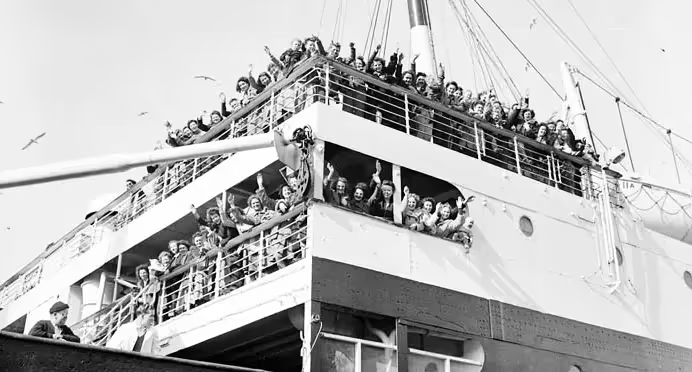Canadian War Brides, 1940-1945
Canadian War Brides, Second World War
One day, the war ended - but not the story of Canadians overseas. Many brought back a family.
An estimated 48,000 young women met and married Canadian servicemen during the Second World War. Most of them came from England, but a few thousand were also from other areas of Europe, including the Netherlands, Belgium, France, Italy and Germany.
War brides began arriving in Canada as early as 1940 and up until 1944 about 1,500 brides had come to Canada. The official transportation scheme began in August 1944 with the establishment of the Canadian Wives Bureau in London. For more info and stats visit www.veterans.gc.ca/eng/remembrance/history/second-world-war/canadian-war-brides, and www.canadianwarbrides.com.
Most of the 48,000 young women who had married Canadian servicemen, and their 22,000 children, were brought to Canada between 1942 and 1947, with the majority arriving in 1946. A few Canadian servicewomen married British husbands. These men were also eligible to travel to Canada. Many arrived on the Queen Mary, which had been converted into a troopship. Most arrived at Pier 21 in Halifax, Nova Scotia.

(Library and Archives Canada Photo, MIKAN No. 4752239)
This photograph of a group of R.C.A.F. Officers and N.C.O.'s was taken at Sutton Coldfield, in England, outside of the church of Holy Trinity, after the wedding of W.O. 1 J.J. Deslauriers to Miss Mary Connon. These officers and airmen are all members of the famed Alouette Squadron, of which Deslauriers is Chief Warrant Officer. From left to right: first row: F/L Claude Bourassa, the groomsman; F/O Rosaire Garneau, W.O. 1 J.J. Deslauriers and Mrs. Deslauriers; kneeling in front of the newlyweds, Flight Lieutenant Real St. Amour, adjutant of the French-Canadian squadron; at the right of Mrs. Deslauriers, Corporal Cuillerier, Sgt. Barnes, Warrant Officer Bill McCullough and Corporal Mac; last row, from left to right, Flying Officer Gabriel Langlais, Flying Officer Jean Paul Camire, Sgt. Demontigny, F/S Bud Regnier and Guy Chartier. 425 Squadron, Dishforth, England, 2 November 1944.
Dishforth was the location where 425 Squadron was formed on 25 June, 1942. The nickname “Alouette” signifies the unique French-Canadian aspect of the squadron. The banner under the squadron crest in French reads “Je te plumerai,” which translates to “I shall pluck you” in English. Prior to their first operational mission, 425 Squadron transferred to No. 6 (R.C.A.F.) Group on 1st January, 1943. Dishforth remained the base of operations until the unit moved to North Africa. Together with two other Canadian squadrons, 425 Squadron arrived at Beaufarik in May 1943, transferred to Kairouan/Zina in June, and finally moved to Hani East L.G. in September, spending about a month at this base. In November of 1943, the unit resumed operations from Dishforth following their return to England. In December the squadron was transferred to Tholthorpe where they spent the rest of World War II.
Aircrew of 425 Squadron logged 3,649 sorties in Wellington and Halifax bombers. Lancasters were used for non-operational use at the end of the war to bring the crew home to Canada. The code “KW” designated aircraft operating with this squadron.

(Library and Archives Canada Photo, MIKAN No. 31930790)
Mrs. Elizabeth Rae and daughter Anne aboard the train taking them to Liverpool, where they are to embark on the S.S. Mauretania as part of the first large group of British war brides to sail to Canada, 4 February 1944. This photo was taken by Sgt. Karen Hermeston, a photographer with the Canadian Film and Photo Unit (CFTU) who was tasked with documenting the FIRST official War Bride sailing on the SS Mauretania. The Mauritania brought 900 brides and children to Canada on that sailing.
Brides and their children were assisted to special war bride trains bound for various points across Canada.

(Library and Archives Canada Photo, MIKAN No. 3210426)
War brides and their children en route to Canada, England, 17 April 1944.

(Library and Archives Canada Photo, MIKAN No. 4939386)
A War Bride and child arrive at Bonaventure Station, Montreal, Quebec, 4 March 1946, after sailing to Canada on the S.S. Aquitania.

(Library and Archives Canada Photo, MIKAN No. 3352284)
War brides en route to Canada aboard the S.S. Letitia, 2 April 1946.

(Library and Archives Canada Photo, MIKAN No. 3352284)
Mrs. J.W. Perry, a war bride, and her daughter Sheila aboard S.S. Letitia en route to Canada, 2 April 1946.

(Library and Archives Canada Photo, MIKAN No. 3523781)
Red Cross Assistant Matron Kathleen Hurley helping war bride Mrs. H.F. Whitmore and her son Mervin, who are en route to Canada. Maple Leaf Club, London, England, 4 December 1944.

(Library and Archives Canada Photo, MIKAN No. 3352281)
Sally Cuthbert of the Canadian Red Cross pouring tea for Mrs. Ivan McArthur, a war bride, and her son Robert, who are en route to Canada to join Mr. McArthur, 4 February 1946.

(Library and Archives Canada Photo, MIKAN No. 3220656)
War bride Beatrice Rousseau meeting her sisters-in-law, 18 September 1945.

(Library and Archives Canada Photo, MIKAN No. 3200841)
Personnel of the 4th Canadian Armoured Division and their Dutch fiancées, Amersfoort, Netherlands, 16 November 1945.

(Library and Archives Canada Photo, MIKAN No. 3523780)
Leading Wren Evelyn Kerr (right) of the Women's Royal Canadian Naval Service (WRCNS) interviewing British wives of Canadian sailors, Canadian Wives Bureau, London, England, 30 November 1944.

